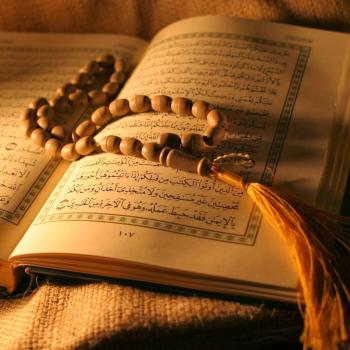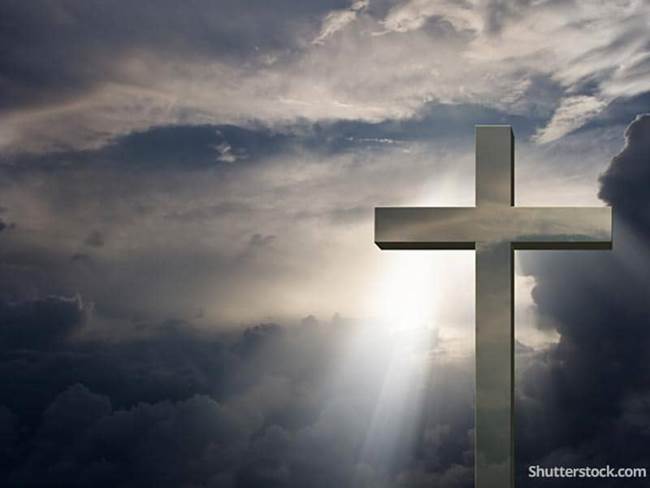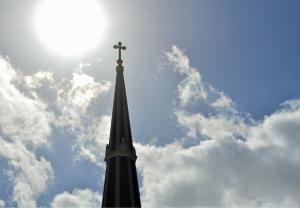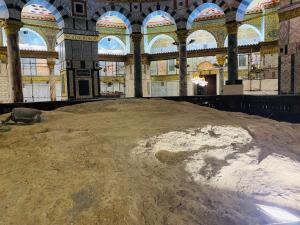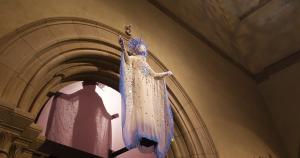 This month’s Met Gala broke the Internet, as intended. This time with celestial, papal, regal flair. But beyond the outrageous red-carpet sequins—the sexy angels and coquettish monks—it is the theme of this year’s five-month-long costume exhibition staged inside the Metropolitan Museum that’s the real provocation. While I’m neither a fashionista nor a Catholic, I stumbled into the show the day after it opened to the public on a research trip to the museum’s Islamic galleries. Where the selfie-sticks and crowds had assembled, I followed. The atrium’s scaffolding was still being deconstructed from the night before while images of Pope Rihanna with accompanying screams of “Sacrilege!” from the outrage police were making the digital rounds. But what seems to be little discussed in the noise are the extraordinary ways in which the accompanying exhibition bridges the sacred and the secular. It transcends the noise.
This month’s Met Gala broke the Internet, as intended. This time with celestial, papal, regal flair. But beyond the outrageous red-carpet sequins—the sexy angels and coquettish monks—it is the theme of this year’s five-month-long costume exhibition staged inside the Metropolitan Museum that’s the real provocation. While I’m neither a fashionista nor a Catholic, I stumbled into the show the day after it opened to the public on a research trip to the museum’s Islamic galleries. Where the selfie-sticks and crowds had assembled, I followed. The atrium’s scaffolding was still being deconstructed from the night before while images of Pope Rihanna with accompanying screams of “Sacrilege!” from the outrage police were making the digital rounds. But what seems to be little discussed in the noise are the extraordinary ways in which the accompanying exhibition bridges the sacred and the secular. It transcends the noise.
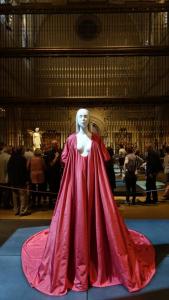 For the past year, I’ve been researching the idea of “cultural” Muslims—the material and lived culture inspired by an Islamic imagination but not by narrow orthodoxy. As someone who doesn’t always fulfill my own five pillars without fault, I’ve often wondered and been bluntly asked if I’ve lost the claim to my Muslimness. The “Heavenly Bodies” show that inspired this week’s viral red-carpet designs is subtitled “Fashion and the Catholic Imagination.” In a landmark co-production between Pope Francis’ woke Vatican and the Metropolitan Museum, this show takes on the imagined firewall between the sacred and the secular in a masterful stroke of collaboration. What does it mean for many of the featured contemporary (often gay) designers raised in the Catholic tradition to draw from their heritage? What does it mean to have a religious “imagination” and not be religious—and how can art blur and widen those categorical prisons?
For the past year, I’ve been researching the idea of “cultural” Muslims—the material and lived culture inspired by an Islamic imagination but not by narrow orthodoxy. As someone who doesn’t always fulfill my own five pillars without fault, I’ve often wondered and been bluntly asked if I’ve lost the claim to my Muslimness. The “Heavenly Bodies” show that inspired this week’s viral red-carpet designs is subtitled “Fashion and the Catholic Imagination.” In a landmark co-production between Pope Francis’ woke Vatican and the Metropolitan Museum, this show takes on the imagined firewall between the sacred and the secular in a masterful stroke of collaboration. What does it mean for many of the featured contemporary (often gay) designers raised in the Catholic tradition to draw from their heritage? What does it mean to have a religious “imagination” and not be religious—and how can art blur and widen those categorical prisons?
Heavenly Bodies
The dresses on show by Christian Dior, Valentino and Dolce & Gabbana (among others) adorn meditative white mannequins that float above, lie across, and stand in the center of the Met’s existing Christian galleries. These are the “Heavenly Bodies” in question. In a show that recreates the experience of walking through a Cathedral, bombastic classical orchestrations and dramatic lighting heighten the celestial mood as contemporary designs are strategically positioned among ancient religious artifacts. It’s a master stroke of exhibition design that suddenly replaces the clutter and chaos of walking through a crowded show with an air of timeless reverence. In the catalogue that accompanies the exhibition, curator Andrew Bolton cites the idea of an enchanted state. “According to sociologist Father Andrew Greely, metaphor is the essential characteristic of a distinctly Catholic sensibility, or consciousness, which he defines as the ‘the Catholic imagination.’ In his book of the same title, Greely asserts: ‘Catholics live in an enchanted world, a world of statues and holy water, stained glass and votive candles, saints and religious medals, rosary beads and holy pictures. But these Catholic paraphernalia are mere hints of a deeper and more pervasive religious sensibility which inclines Catholics to see the Holy lurking in creation.’”
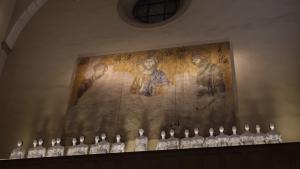 The Vatican’s own participation in and approval of the show challenges the Catholic moral outrage police offended by it. There is a conscious recognition in the accompanying essay by Cardinal Gianfranco Ravasi that Roman Catholic aesthetics, the flair for the dramatic and operatic, the blood reds and celestial forms, are a means of universal inspiration—a part of our global imagination. “Beauty and art have been the inseparable sisters of faith and Christian liturgy for centuries, especially in Catholicism and orthodoxy … the bond between beauty and faith continues to revive and renew itself through a dialogue with contemporary art.”
The Vatican’s own participation in and approval of the show challenges the Catholic moral outrage police offended by it. There is a conscious recognition in the accompanying essay by Cardinal Gianfranco Ravasi that Roman Catholic aesthetics, the flair for the dramatic and operatic, the blood reds and celestial forms, are a means of universal inspiration—a part of our global imagination. “Beauty and art have been the inseparable sisters of faith and Christian liturgy for centuries, especially in Catholicism and orthodoxy … the bond between beauty and faith continues to revive and renew itself through a dialogue with contemporary art.”
The Muslim Imagination
One floor above the Medieval Christian galleries, where these costumes are staged as a dramatic ‘intervention,’ are the museum’s storied Islamic galleries that I’ve been researching. In the same moment that anxieties about Muslim orthodoxy and rigidity are driving so many political crises, these centuries of material culture—paintings, carpets, and jewels—reveal a heritage of aesthetics, design and sublime beauty that can’t be denied its appeal. As the curator of the Islamic galleries, Navina Haidar, once told me, the Met’s goal is to showcase “the Islamic heritage of the world rather than the heritage of the Islamic world.” There is an important distinction.
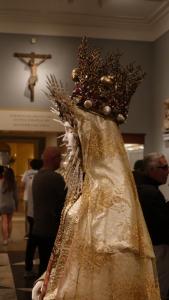 As I left the new “Heavenly Bodies” exhibition, I got to thinking (channeling my inner Carrie Bradshaw perhaps?) what a “Design and the Islamic Imagination” exhibition could look like. The ways in which non-practicing “cultural” Muslims create works of contemporary resonance and universal allure still inspired by their particular imagination—the arabesque landscape design in the Middle East and flourishing hijabi fashion in Europe. Is it Islamic art? Is it sacred, secular, profane, or none of the above? Of course, without a central clerical body like the Vatican to participate in and sponsor such a show, the risk of a pop-up arbiter of Islamic propriety and resulting outrage machine (digital and analogue) loom large. That said, such a show would be an extraordinary chance to challenge those assumed categorical divisions. Fortunately, I was happy to learn, this very idea is already on the mind of curator Andrew Bolton who recently told an interviewer it’s in the works to follow “Heavenly Bodies.” Now that Pope Rihanna has won the internet with her miter, an Islamic Met Gala could be next, and what a welcome provocation it would be.
As I left the new “Heavenly Bodies” exhibition, I got to thinking (channeling my inner Carrie Bradshaw perhaps?) what a “Design and the Islamic Imagination” exhibition could look like. The ways in which non-practicing “cultural” Muslims create works of contemporary resonance and universal allure still inspired by their particular imagination—the arabesque landscape design in the Middle East and flourishing hijabi fashion in Europe. Is it Islamic art? Is it sacred, secular, profane, or none of the above? Of course, without a central clerical body like the Vatican to participate in and sponsor such a show, the risk of a pop-up arbiter of Islamic propriety and resulting outrage machine (digital and analogue) loom large. That said, such a show would be an extraordinary chance to challenge those assumed categorical divisions. Fortunately, I was happy to learn, this very idea is already on the mind of curator Andrew Bolton who recently told an interviewer it’s in the works to follow “Heavenly Bodies.” Now that Pope Rihanna has won the internet with her miter, an Islamic Met Gala could be next, and what a welcome provocation it would be.
Bilal Qureshi is a culture writer and radio journalist. He was born in Kohat, Pakistan and grew up in Richmond, Virginia. Bilal’s essays have appeared in The New York Times, The Washington Post, NPR.org and Newsweek. His column Elsewhere appears in Film Quarterly magazine, exploring international cinema in print and podcast. http://www.bilalq.com.
All images by the author, Bilal Qureshi, with permission.




